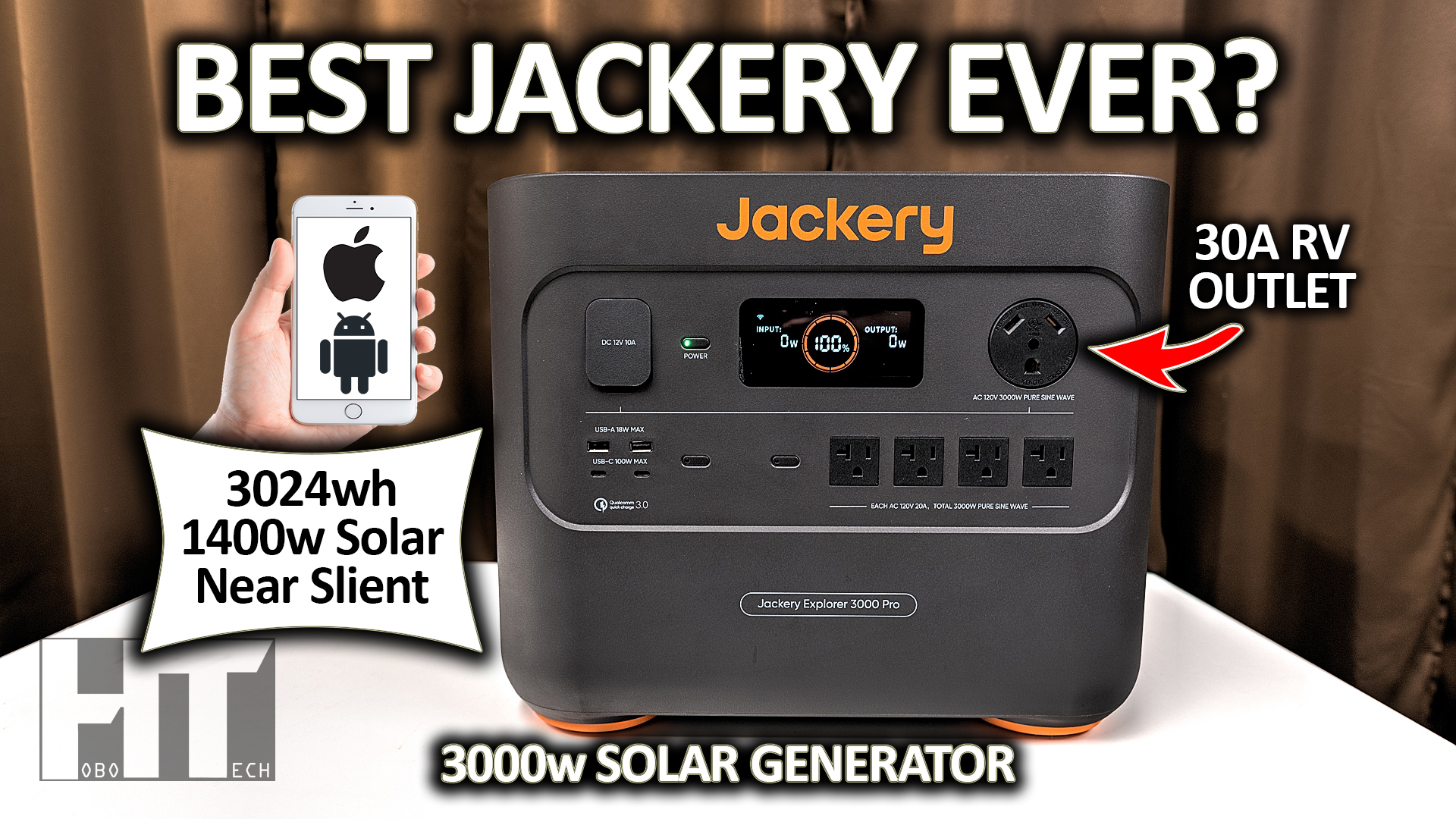
Watch The Video On YouTube
The Professor reviews the new JACKERY 3000 PRO with 3000w inverter, 3024wh lithium battery, 1400w solar support, UPS, and a NEW APP!
WATCH IT HERE
Intro:
-
In May of ‘22 I reviewed the all new Jackery 2000 Pro and it turned some heads with its new folding handle design and built in charger with UPS feature. A few months later I reviewed its little brother the 1000 Pro. Fast forward to today and Jackery launches it’s biggest power station to date – the new 3000 Pro. With 3000 watts of power, 1400w of solar support, and debuting a brand new mobile APP for remote access, we have to ask … is it any good? Let’s find out!
Features:
-
Battery Capacity/Tech/Cycles: 3024wh NMC lithium ion battery rated 2000 cycles to 70% in battery saver mode
-
Size/Weight: approx 19x14x15 inches and weighs 63 lbs
-
Design/Display: As with the other Jackery Pro models the 3000
-
Inverter Size/Type (constant/peak) and #outlets: 3000w pure sine inverter with 4x20A outlets and a TT30R 30A RV outlet.
-
Ways To Charge (and times for each): The Jackery has 3 ways to charge. It offers AC wall charging at 1800w in 2.4 hours, dual MPPT 1400w solar charging in 3-4 hours, and finally 12v vehicle charging in 35 hours.
-
12v Output Types: This Jackery sports a single 13.2v regulated 12v outlet good for 10A
-
USB Output Types: As for USB it has a pair of USB-A QC ports and a pair of 100w USB-C PD outputs. Note these are output only and the Jackery can not be charged with USB.
-
Other Features: Jackery has finally decided to join the remote access club and now offers a bluetooth App for this product that also supports WiFi. So, yes you can control the 3000 Pro with your mobile device remotely.
-
Warranty: Jackery does offer a 5 year warranty on this product when registered on their site.
Testing
-
DC Battery Capacity Test (time lapse): On the DC test this Jackery scored 2618wh out of 3024 for 87% usable capacity.
-
AC Battery Capacity Test (time lapse): As for AC it faired 2540wh out of 3024 or 84%. These numbers are average to slightly above average for the industry. Previous pro models scored a touch higher on the AC test but this one scored a bit lower due to it’s massive 3000w inverter. The larger the inverter the more wasteful it’s going to be.
-
Sine wave check under load:120v 60hz
-
Inverter capacity test (max): 3500w 5s
-
Cooling ability test (rated @ 5mins): 3000w max
-
Inverter fan noise db:51
-
Max Charge Rate @ watts/volts: AC 1730w, DC @60v*2 1200w
-
Charging fan noise db: solar fast 50, solar slow 42, AC 46
-
Simultaneous charging ability: 2200w solar priority
-
Pass thru / UPS: UPS passes laptop test
-
DC Output(s) Max Rate: 10A
-
12v output(s) regulated: 13.2v
-
USB output rate check: 100w*2 pass
-
Amp interference test: pass
-
APP test: pass
What do I think about it? (main pro/con):
-
What do I think about the most powerful Jackery to date? The lack of LFP tech and battery expandability are Debbie downers. However, it’s actually a gosh darn solid offering. It has everything short of a wireless charging pad and a lamp that I think most folks would want. With the RV output you can power your entire RV (up to about 25A) including the air conditioner. With the dual PD outputs you can charge two high end laptops and a pair of modern cell phones at the same time.
-
It’s super easy to use, in fact maybe the easiest Jackery to date since it has less buttons and less clutter up front. I like that the inputs are on the back. It’s easy to carry and wheel around and in all honestly can pretty much now run with the big boys.
-
Finally with a remote app you can control the Jackery without ever needing to touch it which is important if it’s sitting on the ground or in a cubby in your RV. The inverter output is clean enough to power your band, and the UPS/EPS “bypass” feature switches fast enough to keep computers and routers going in a blackout. They are even launching at a reasonable and competitive price. I can say that this has to be the “best Jackery yet” and it will be a rock solid purchase for many folks looking for something lighter and more portable than what the other kids in the playground offer.
Pricing and competition
-
Product Price with current discounts:
-
The 3000 Pro retails for $2799 which, being under a buck a watt, is the lowest price per watt Jackery has offered on any of their recent products. For example, both the 1000 Pro and 2000 Pro currently go for over a dollar per watt. Now as a HOBOTECH viewer you’re not going to pay $2799 for the 3000 Pro, because I nabbed an exclusive, limited time discount code that will knock a few hundred bucks off the price of both the 3000 Pro by itself and the “solar generator” bundle with 400w of solar panels. I’m not sure exactly how much, but if you want to find out, click the link below in the description and add the discount code provided at checkout to see the final cost.
-
-
Main Competitor:
-
Now this Jackery being 3000w is a direct competitor against the 3000w Bluetti AC300 and 3600w Ecoflow Delta Pro. The two major differences are that the Jackery is using NMC batteries where the others are using LiFePO4, and that the Jackery offers no battery expansion options. However, both the Delta Pro and Bluetti weigh over a 100lbs whereas the Jackery is only 63lbs. That’s what Jackery is all about… portability. They offer both heavy duty handles and a luggage style pull handle with wheels to make it as easy as possible to move that 60 plus pounds around. By cubic inches it’s also quite a bit smaller than the 3000w competition. It’s really your personal choice which one to go with depending on your needs.
-
-
Who’s It Aimed At? (market focus):
-
This Jackery, without expandable batteries, really isn’t a whole house backup solution so it can’t be treated as such. Jackery as a brand is more about power on the go, be it camping, having a cookout on the beach, tailgating, or running stuff in a boat, RV, or cabin. This one can obviously be used in the home as well to power things like refrigerators, microwaves, TV’s, fans, air conditioners, heaters and the like. It should even have enough power to start a furnace during a blackout so it could keep the heat on.
-
-
Recommended Solar Panel Type/Size:
-
Jackery uses a proprietary solar panel setup so they “strongly encourage” you to use their solar panels in bundle packages they call “solar generators”. Because of the difficulty in using 3rd party panels, I’d suggest if you don’t have panels already that you just get a bundle with theirs as they are high quality and high output but do so at a premium.
-
If you want a more permanent and low cost solution, I’d recommend the BougeRV 200w or the Renogy 320w panels that can be found on hobotech.tv/amazon under “solar kits”. You’re also going to need a pair of MC4 to 8mm adapters under the “solar adapters” section (links are below).
-
Jackery does provide a pair of 7909 to 8020 or what I call “thin pin to thick pin” adapters in the box. Jackery solar inputs are all 8020 “thick pin” and without the adapter, a standard 8mm adapter from Amazon won’t work. With both the MC4 to 8mm and 8020 adapter you can use any 3rd party solar panels in series up to 60v into each of the solar inputs. Remember that each input on the Jackery maxes out at around 800w of solar.
-
-
If you’re interested, get the 3000 PRO: https://gohobo.io/j3kpro [3000 PRO w/400w Panels: https://gohobo.io/j3ksogen ] use code HOBOTECH2023 at checkout.
-
Jackery Solar Adapters: https://gohobo.io/adapters
-
Get 10% off all other Jackery products using code HOBOTECH https://gohobo.io/jackery
Jackery 3000 Pro
3000w UPS Generator
Use code HOBOTECH2023
GO TO JACKERY
Growatt Vita 550
600w Solar Generator
Use code OLHOBOFANS
GO TO GROWATT
Growatt Infinity 1500
2000w Solar Generator
Use code HOBOSFANS
GO TO GROWATT
Bluetti PV420 420w
Portable Solar Panel
Use code HOBOPV420
GO TO BLUETTI
Dr. Prepare 100ah
LiFePO4 PowerMax Battery
Use code HOBO7
GO TO DR PREPARE
Power Queen 190ah
LiFePO4 Drop In Battery
Use code HOBO9 for $605 offer
GO TO POWER QUEEN
Vigorpool Captain 1200
UPS LFP Parallel SoGen
GO TO VIGORPOOL
ZENDURE SBP 2000
SOLAR GENERATOR
$100 OFF code HOBOSBP
GO TO ZENDURE
BLUETTI EB3A UPS
SOLAR GENERATOR
Use code HOBOEB3A
GO TO BLUETTI
RUNHOOD POWER
MODULAR GENERATOR
GO TO RUNHOOD
ECOFLOW WAVE
BATTERY POWERED A/C
Use code HOBOTECHWAVE
GO TO ECOFLOW
RENOGY LYCAN 5000
4800wh UPS Waterproof
Solar Generator
12% off with code HOBOLYCAN1
GO TO RENOGY
—
GOT RENOGY SOLAR PANELS?
Renogy 450w solar panels: https://hobos.cc/ren450
Renogy 175w solar panels: https://hobos.cc/ren175
Use code HOBOPANEL for 10% off
ACOPOWER
LiON Mini Fridge
$226 Super Early Bird!
GO TO ACOPOWER
BougeRV 1200w
1100wh SoGen
$719 code HOBOTECH10
GO TO BOUGERV
Jackery 2000 Pro
2200w UPS SoGen
$2069 code HOBOTECH
GO TO JACKERY
ICECO JPPRO 12v Fridge
Only $479 for a limited time!
GO TO ICECO PAGE
PECRON E3000 3108wh
Only $1899 for a limited time!
Use code HOBOE3000 until May 7th
GO TO PECRON SITE
BIGBLUE CELLPOWA 2500w
Only $1099 for a limited time!
GO TO BIGBLUE SITE
BLUETTI EP500 PRO
See the review?
GO TO BLUETTI POWER SITE
//-AC300 & B300 Deals-//
B300 (solo) Use code HOBOB300 https://bit.ly/3hyROWi
AC300+B300 Use code HOBOAC3001B https://bit.ly/398DDm1
AC300+2xB300 Use code HOBOAC3002B https://bit.ly/3Aq3OAs
AC300+2xB300+3xPV200 Use code HOBOAC300COMBO2 https://bit.ly/3tJHFuD
2xAC300+2xB300+P030A Use code HOBOAC300COMBO1 https://bit.ly/3lpWoXU
AC300+4xB300 Use code HOBOAC3004B https://bit.ly/3tVd1Pb
2xAC300+4xB300+P030A Use code HOBOAC300COMBO3 https://bit.ly/2Xmd8XL
2xAC300+4xB300+6xPV200+P030A Use code HOBOAC300COMBO4 https://bit.ly/2XmDDfp
//-AC200Max & B230 Deals-//
B230 (solo) Use code HOBOB230 https://bit.ly/3EiO4Sk
AC200MAX Use code HOBO200MAX https://bit.ly/3EiOBni
AC200Max+B230 Use code HOBOMAXB230 https://bit.ly/3znZzEB
AC200Max+3PV200 Use code HOBOMAX3PV2000 https://bit.ly/39b8lLs
AC200Max+2*B230 Use code HOBOMAX2B230 https://bit.ly/3k9D7ue
AC200Max+2*B230+3*PV200 Use code HOBOMAXCOMBO https://bit.ly/3kb2A6w
//-AC200P-//
AC200P Use code HOBO200P https://bit.ly/3JSgGDR
AC200P+3xPV120 Use code AC200PV120 https://bit.ly/3555Yes
AC200P+3xPV200 Use code AC200PV200 https://bit.ly/3t9pPBg
//-UNDER 1000w-//
AC50S Use code HOBO50 (or HOBO50OR) https://bit.ly/3skt7me
EB55 Use code HOBO55 https://bit.ly/3hfqw6x
EB70S Use code HOBO70S Use code HOBO100 https://bit.ly/3C311iF
EB150 Use code HOBO150 https://bit.ly/3pgyr85
EB240 Use code HOBO3000 https://bit.ly/3Ka7drZ
EB55+PV120 Use code PVEB55 https://bit.ly/3BMIpDn
EB70S+PV200 Use code EB70S30 https://bit.ly/3sfYu1c
EB150+2xPV120 Use code EB150PV120 https://bit.ly/3t7PmuM
EB240+2xPV120 https://bit.ly/33OMk61
//-SOLAR PANELS-//
PV120 Use code HOBO100 https://bit.ly/3LZXAO3
PV200 Use code HOBO200 https://bit.ly/3vgmjrq
PV350 Use code HOB350 https://bit.ly/3hIr1Gs
//-ACCESSORIES-//
DC Charging Enhanncer(D050S) Use code HOBOENHANCER https://bit.ly/2Xs3mnd
Fusion Box Pro(P030A)Use code HOBOFUSION https://bit.ly/3AcUQqs
PV voltage step down module(D300S) Use code HOBOD300S https://bit.ly/3nByuv1
D050S+3*PV200+B230 Use code HOBOENHCOMBO1 https://bit.ly/3nzNKJ9
D050S+3*PV200+B300 Use code HOBOENHCOMBO2 https://bit.ly/2XhAuh1
–ALLPOWERS MONSTER PRO–
5000wh UPS LFP SOGEN
Only $3399 for a limited time!
That’s 67 cents per watt hour! Cheap!
GO TO ALLPOWERS SITE
OUPES 1200w Solar Generator
Only $765 for a limited time!
Use Code HOBOTECH for 15% off SITE WIDE
GO TO OUPES SITE
GET THE BLUETTI AC200P at the LOWEST PRICE EVER!
BLUETTI AC200P 2000wh LiFePO4
Only $1498 from BLUETTI
https://bit.ly/2T3xMJK
Use Code HOBO200P
or purchase from Amazon + tax support & Bezos Yacht Fund
PLEASE SUPPORT US BY BUYING DIRECT FROM BLUETTI
BEZOS DOESN’T NEED ANOTHER YACHT!
MONTEK X-1000 Water Resistant 1000w SoGen
MONTEK X-1000 (with 80w panel): http://shrsl.com/3cm8o use code HOBO1000 for $100 off!
ACOPower LiONCooler Pro Solar Fridge
https://bit.ly/3Dp5hYH
ANKER 521 256wh LFP Power Station
https://amzn.to/3nZUT51
BLUETTI AC300
3000w Solar Generator
“BEST SOGEN AVAILABLE IN 2021!”
ON SALE NOW!
Use the codes / links below!
//-AC300 & B300 Deals-//
B300 (solo) Use code HOBOB300 https://bit.ly/3hyROWi
AC300+B300 (review bundle) Use code HOBOAC3001B https://bit.ly/398DDm1
AC300+2xB300 Use code HOBOAC3002B https://bit.ly/3Aq3OAs
AC300+2xB300+3xPV200 Use code HOBOAC300COMBO2 https://bit.ly/3tJHFuD
2xAC300+2xB300+P030A Use code HOBOAC300COMBO1 https://bit.ly/3lpWoXU
AC300+4xB300 Use code HOBOAC3004B https://bit.ly/3tVd1Pb
2xAC300+4xB300+P030A Use code HOBOAC300COMBO3 https://bit.ly/2Xmd8XL
2xAC300+4xB300+6xPV200+P030A Use code HOBOAC300COMBO4 https://bit.ly/2XmDDfp
//-AC200Max & B230 Deals-//
B230 (solo) Use code HOBOB230 https://bit.ly/3EiO4Sk
AC200MAX Use code HOBO200MAX https://bit.ly/3EiOBni
AC200Max+B230 Use code HOBOMAXB230 https://bit.ly/3znZzEB
AC200Max+3PV200 Use code HOBOMAX3PV2000 https://bit.ly/39b8lLs
AC200Max+2*B230 (review bundle) Use code HOBOMAX2B230 https://bit.ly/3k9D7ue
AC200Max+2*B230+3*PV200 Use code HOBOMAXCOMBO https://bit.ly/3kb2A6w
//-Other Models-//
AC200P 2000wh https://bit.ly/2T3xMJK use code HOBO200P
EB70 700w LiFePO4 https://bit.ly/2SfeEIK use code HOBO70
EB55 700w LiFePO4 https://bit.ly/3CmRHFq use code HOBO55
AC50s 500wh https://bit.ly/3uNec1O use code HOBO50
AC50s (orange) https://bit.ly/2T1TUEx use code HOBO50OR
EB240 2400wh https://bit.ly/3cjMseB use code HOBO3000
EB150 1500wh https://bit.ly/3plw3vL use code HOBO150
//-Solar Panels-//
BLUETTI PV200 200w Solar Panel https://bit.ly/31b1n8o use code HOBO200
BLUETTI PV120 120w Solar Panel https://bit.ly/3Emrtn8 use code HOBO100
//-Accessory Deals-//
DC Charging Enhanncer(D050S) Use code HOBOENHANCER https://bit.ly/2Xs3mnd
Fusion Box Pro(P030A) Use code HOBOFUSION https://bit.ly/3AcUQqs
PV voltage step down module(D300S) Use code HOBOD300S https://bit.ly/3nByuv1
D050S+3*PV200+B230 Use code HOBOENHCOMBO1 https://bit.ly/3nzNKJ9
D050S+3*PV200+B300 Use code HOBOENHCOMBO2 https://bit.ly/2XhAuh1
HIBOOST BOOSTERS!
-> https://bit.ly/3DLf0Kn <-
Use code HOBO20 for 20% off the OTW, RV, and Car boosters.
Use code HOBO15ALL for 15% off everything else SITE WIDE! (including home boosters!)
NEW BLUETTI AC200Max !
AC200Max: use code HOBO200MAX https://bit.ly/3mjdKIa
AC200Max+B230: use code HOBOMAXB230 https://bit.ly/3xZJCUg
AC200Max+2*B230: use code HOBOMAX2B230 https://bit.ly/3z3L8Gh
AC200Max+2*B230+600w solar: use code HOBOMAXCOMBO https://bit.ly/3D1SEUr
AC200Max+600w solar: use code HOBOMAX3PV2000 https://bit.ly/2WbTMnS
BROWSE OTHER DEALS: https://bit.ly/3ydwhId
SUNGOLDPOWER 130w v.2 Suitcase Kit
is BACK !
Use code HOBOTECH at checkout
GET IT AT SUNGOLDPOWER
Watch the original V.1 review video HERE
Amazon (no discount): https://amzn.to/3iJFRht
JACKERY EXPLORER 1000
GET IT AT JACKERY (save tax)
use code HOBOTECH at checkout!
Amazon: https://amzn.to/38TEJiR
CANADA https://amzn.to/3d7ll5g
PLEASE SUPPORT US AND NOT BILLIONAIRES BY BUYING DIRECT!
ECOFLOW DELTA PRO
3600w LiFePO4 UPS Power Station
CHECK IT OUT HERE
ICECO Refrigerators
->CLICK HERE for BEST DEALS!<-Use code HOBOTECH at checkout!
BOUGERV DEALS!
BOUGERV 180w Solar Panels
Use code HOBOTECH at checkout for 12% off the ENTIRE Solar Catalog!
Get BOUGERV 180 WATT SOLAR PANELS HERE
BougeRV Cheap REFRIGERATORS!
Use code HOBOTECH20 for 20% off all models!
53qt use code HOBOTECH90 for $90 off!
BUY DIRECT FROM BOUGERV
Wanna buy Bezos another Yacht instead?
53qt (Canada) https://amzn.to/332dgeX use code V7DIVCAB
The 5100wh Home Backup BEAST!
BLUETTI EP500 / EP500 PRO
GET IT NOW
JACKERY EXPLORER 1500
GET IT AT JACKERY (save tax)
Amazon +tax: https://amzn.to/3sUvbyU
PLEASE SUPPORT US AND NOT BILLIONAIRES BY BUYING DIRECT!
JACKERY SG1500 + 4x100w Panels
GET IT AT JACKERY (save tax)
on Amazon +tax: https://amzn.to/3rQCFld
PLEASE SUPPORT US AND NOT BILLIONAIRES BY BUYING DIRECT!
BLUETTI EB70 700w Solar Generator
Use Code HOBO70 for $100 off
GET IT AT BLUETTI (save tax)
Only red & gray available. Mint green is sold out.
PLEASE SUPPORT US AND NOT CORPORATE BILLIONAIRES BY BUYING DIRECT.
AMAZON TAKES UP TO 25% FROM SELLERS!
HIBOOST RV BOOSTER
GET IT AT HIBOOST
Use code HOBO20 for 20% OFF all mobile units!
JACKERY 300 Version 2.0!
Get it at the new low price of $299!
Jackery Direct (save tax) https://bit.ly/2QEQ9AB
On Amazon (+tax): https://amzn.to/3lCbbhl
PLEASE SUPPORT US BY BUYING DIRECT FROM JACKERY
BEZOS DOESN’T NEED THE HELP!
ALP 1000w Generator + Free Tank Hose
Get the ALP in several color choices for $499
1) Add generator to cart: ALP Generator
2) Add hose to cart: Generator Hose
3) Use code HOBO1020 at checkout!
ECOFLOW DELTA 1300 $1149
EcoFlow Store Page!
Use code EFHOBOTECH50 !
BLUETTI AC50S Solar Generator
— ->CLICK HERE for BEST DEAL!<- —
Use code HOBO50
Or buy on Amazon: https://amzn.to/36fwWg0
ICECO JP Series Refrigerators 20% OFF!
— ->CLICK HERE for BEST DEAL!<- —
Use code HOBOTECH at checkout!
HIBOOST 4G Signal Boosters
–> CLICK HERE FOR BEST DEAL! <–
Use code 2CX3RBZJ for 10% off SITE WIDE!
NEW! Use code XRMJT8WE for 20% off RV CELL BOOSTER!
ACOPOWER LiONCooler: https://www.acopower.com/
Use code HOBOTECH at checkout for 10% off!
SUNGOLDPOWER 130w Suitcase Kit is BACK
for $208! Use code 15HOBOTECH
Watch the original review video HERE
–> CLICK HERE for Amazon Page <–
Using the preferred “Best Deal” links helps support the channel!
Visit hobotech.tv/amazon for ALL products and discounts!
HOBOTECH is viewer supported. When you buy through these links we may earn an affiliate commission. As an Amazon Associate I earn from qualifying purchases.
#reviews #generators #offgrid

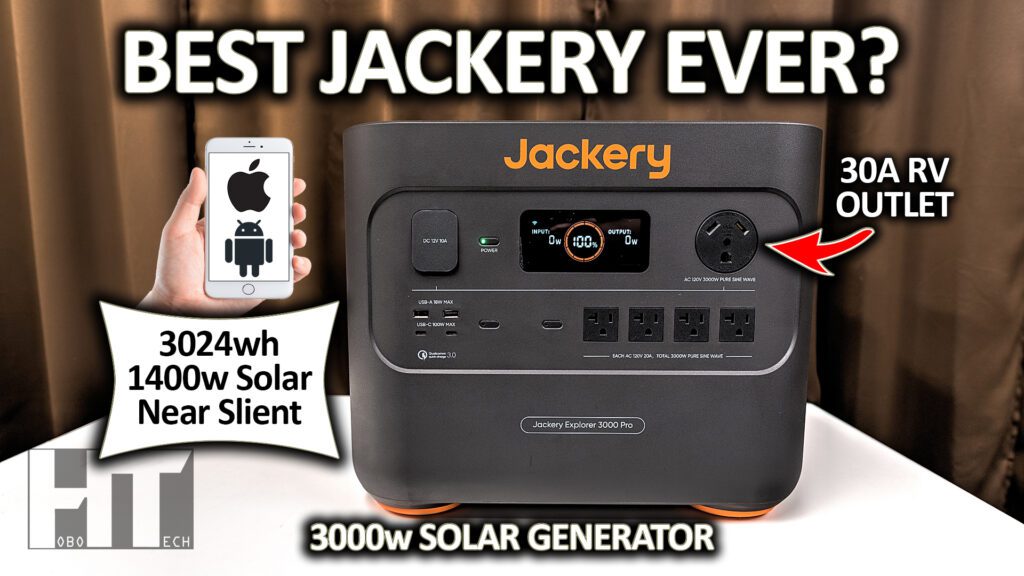







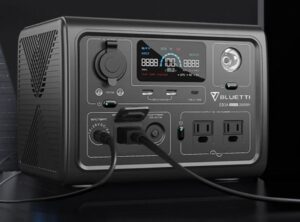




















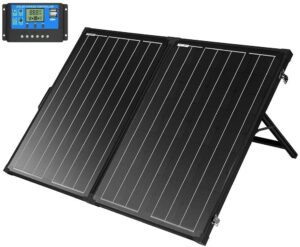









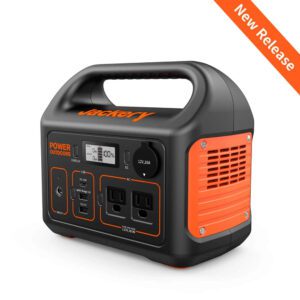


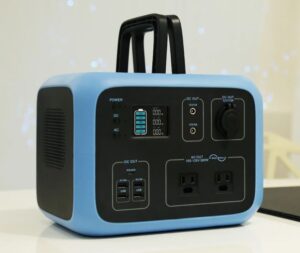







You must be logged in to post a comment.